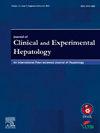Epidemiological Dynamics of Burden and Health Inequalities in Metabolic Dysfunction-associated Steatotic Liver Disease in Adolescents at Global, Regional, and National Levels, 1990–2021
IF 3.3
Q2 GASTROENTEROLOGY & HEPATOLOGY
Journal of Clinical and Experimental Hepatology
Pub Date : 2025-02-28
DOI:10.1016/j.jceh.2025.102537
引用次数: 0
Abstract
Background
Metabolic dysfunction-associated steatotic liver disease (MASLD) has become one of the major causes of chronic liver disease among adolescents. However, epidemiological studies on MASLD in adolescents are still insufficient. In this study, we aim to investigate the global burden and the trend of MASLD in adolescents from 1990 to 2021.
Methods
The age-standardized incidence, prevalence, mortality, and disability-adjusted life years (DALYs) of MASLD were calculated based on the Global Burden of Disease (GBD) 2021 study and stratified by sex, socio-demographic index (SDI), GBD regions, and countries. The temporal trends were examined using the average annual percentage change (AAPC) and joinpoint regression.
Results
From 1990 to 2021, the global trends of age-standardized incidence rate (ASIR) and age-standardized prevalence rate (ASPR) of MASLD show notable increase, and the male is significantly higher than the female in adolescents. According to the incidence and prevalence, nations with low SDI confront a higher burden of MASLD. Besides, the inequality of incidence and prevalence between different SDI regions have shrunk in 2021, but the inequality of DALYs and mortality are still exacerbated. Decomposition analysis revealed that population growth and epidemiological changes were the main reasons for the increase in the incidence of MASLD.
Conclusion
From 1990 to 2021, there is a significant upward trend in the incidence of MASLD among adolescents worldwide. Of particular note are male adolescents, East Asian regions, and groups living in high SDI countries.

1990-2021年全球、地区和国家青少年代谢功能障碍相关脂肪变性肝病负担和健康不平等的流行病学动态
背景:代谢功能障碍相关脂肪变性肝病(MASLD)已成为青少年慢性肝病的主要病因之一。然而,青少年MASLD的流行病学研究仍然不足。在这项研究中,我们旨在调查1990年至2021年青少年MASLD的全球负担和趋势。方法基于全球疾病负担(GBD) 2021研究,按性别、社会人口指数(SDI)、GBD地区和国家分层,计算MASLD的年龄标准化发病率、患病率、死亡率和残疾调整生命年(DALYs)。采用年平均百分比变化(AAPC)和连接点回归分析了时间趋势。结果1990 - 2021年,全球青少年MASLD年龄标准化发病率(ASIR)和年龄标准化患病率(ASPR)呈显著上升趋势,男性显著高于女性。从发病率和流行程度来看,低SDI国家的MASLD负担较高。此外,2021年不同SDI地区之间发病率和患病率的不平等有所缩小,但DALYs和死亡率的不平等仍在加剧。分解分析表明,人口增长和流行病学变化是导致MASLD发病率上升的主要原因。结论从1990年到2021年,全球青少年MASLD发病率有明显上升趋势。特别值得注意的是男性青少年、东亚地区和生活在高SDI国家的群体。
本文章由计算机程序翻译,如有差异,请以英文原文为准。
求助全文
约1分钟内获得全文
求助全文
来源期刊

Journal of Clinical and Experimental Hepatology
GASTROENTEROLOGY & HEPATOLOGY-
CiteScore
4.90
自引率
16.70%
发文量
537
审稿时长
64 days
 求助内容:
求助内容: 应助结果提醒方式:
应助结果提醒方式:


